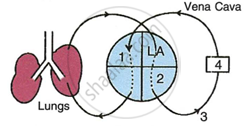Advertisements
Advertisements
प्रश्न
Describe, in brief, the circulatory system in human beings.
उत्तर
The circulatory system in human beings consists of heart, blood vessels (arteries, veins and capillaries) and blood. Blood circulates throughout the body in blood vessels by the pumping action of the heart. The impure blood is carried by veins from all parts of the body to the heart. The heart pumps it into the lungs where blood is oxygenated and carried back to the heart. From heart, the oxygenated (pure) blood is pumped to all parts of the body through arteries.
Thus, the circulatory system forms the transport system carrying food, oxygen, waste products, nutrients etc. throughout the body.
APPEARS IN
संबंधित प्रश्न
Mention the exact location of the Pulmonary semilunar valve
Name the following:
The valve present in between the chambers on the right side of the human heart.
What is Endothelium?
Give any three differences between an artery and a vein
You can see some blood vessels on the outside of the hands specially in older people. Are those veins or arteries? How can you confirm your answer?
True or false:
Blood group A has antigen A.
True or false:
Impure blood is received by the right auricle.
In what ways does the blood entering the kidney differ from that leaving the kidney?
______ is a granulocyte.
Given diagram is a schematic representation of the circulatory system in humans. Study the same and answer the questions that follow:
 |
- Label the parts 1 and 4 indicated in the diagram.
- Which of the above mentioned number is the thickest artery? Also write its name.
- Mention the number and chamber of the heart which has the thickest muscular wall.
- Which of the above numbers/structures has the maximum number of blood capillaries?
- Draw neat and labelled diagrams of the transverse section of vena cava and the part numbered as 3. Make sure to show the structural differences between these two in the diagram.
